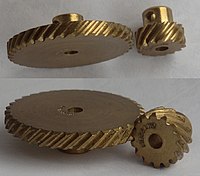
Helical Gears:
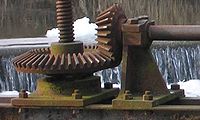
Bevel Gears

Crown Gears

Crank Gear

Worm Gears
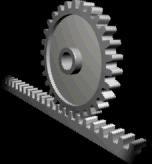
Rack and Pinion gears

Fifth input gear

9 flat gear

Dual idler gear drives
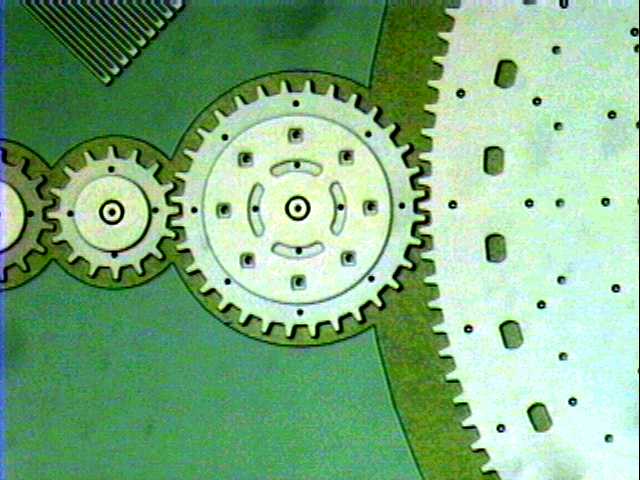
A gear with radius of 80microm
Gear terminology:
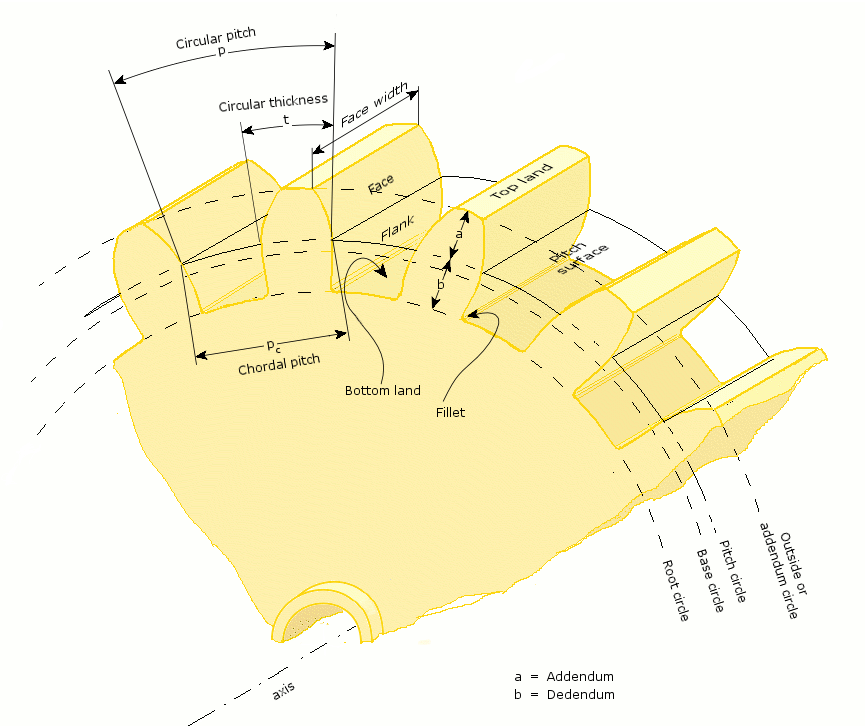
* Common abbreviations
o n. Rotational velocity. (Measured, for example, in r.p.m.)
o ω Angular velocity. (Radians per unit time.) (1 r.p.m. = π/30 radians per second.)
o N. Number of teeth.
* Path of contact. The path followed by the point of contact between two meshing gear teeth.
* Line of action, also called 'Pressure line'. The line along which the force between two meshing gear teeth is directed. It has the same direction as the force vector. In general, the line of action changes from moment to moment during the period of engagement of a pair of teeth. For involute gears, however, the tooth-to-tooth force is always directed along the same line -- that is, the line of action is constant. this implies that for involute gears the path of contact is also a straight line, coincident with the line of action -- as is indeed the case. Further note on tooth force56
* Axis. The axis of revolution of the gear; center line of the shaft.
* Pitch point (p). The point where the line of action crosses a line joining the two gear axes.
* Pitch circle. A circle, centered on and perpendicular to the axis, and passing through the pitch point. Sometimes also called the 'pitch line', although it is a circle.
* Pitch diameter (D). Diameter of a pitch circle. Equal to twice the perpendicular distance from the axis to the pitch point. The nominal gear size is usually the pitch diameter.
* Operating pitch diameters. The pitch diameters determined from the number of teeth and the center distance at which gears operate.2 Example for pinion: d_w = \frac{2a}{u+1} = \frac{2a}{\frac{z_2}{z_1}+1}
* Pitch surface. For cylindrical gears, this is the cylinder formed by projecting a pitch circle in the axial direction. More generally, it is the surface formed by the sum of all the pitch circles as one moves along the axis. Eg., for bevel gears it is a cone.
* Angle of action. Angle with vertex at the gear center, one leg on the point where mating teeth first make contact, the other leg on the point where they disengage.
* Arc of action. The segment of a pitch circle subtended by the angle of action.
* Pressure angle (ø). The complement of the angle between the direction that the teeth exert force on each other, and the line joining the centers of the two gears. For involute gears, the teeth always exert force along the line of action, which, for involute gears, is a straight line; and thus, for involute gears, the pressure angle is constant.
* Outside diameter (Do). Diameter of the gear, measured from the tops of the teeth.
* Root diameter. Diameter of the gear, measured from the base of the tooth space.
* Addendum (a). The radial distance from the pitch surface to the outermost point of the tooth. a = (Do - D) / 2.
* Dedendum (b). The radial distance from the depth of the tooth trough to the pitch surface. b = (D - root diameter) / 2.
* Whole depth (ht). Whole depth (tooth depth) is the total depth of a tooth space, equal to addendum plus dedendum, also equal to working depth plus clearance.2
* Clearance. Clearance is the distance between the root circle of a gear and the addendum circle of its mate.2
* Working depth. Working depth is the depth of engagement of two gears, that is, the sum of their operating addendums.2
* Circular pitch (p). The distance from one face of a tooth to the corresponding face of an adjacent tooth on the same gear, measured along the pitch circle.
* Diametral pitch (Pd). The ratio of the number of teeth to the pitch diameter. Eg., could be measured in teeth per inch or teeth per centimeter.
* Base circle. Applies only to involute gears, where the tooth profile is the involute of the base circle. The radius of the base circle is somewhat smaller than that of the pitch circle.
* Base pitch (pb). Applies only to involute gears. It is the distance from one face of a tooth to the corresponding face of an adjacent tooth on the same gear, measured along the base circle. Sometimes called the 'normal pitch'.
* Interference. Contact between teeth other than at the intended parts of their surfaces.
* Interchangeable set. A set of gears, any of which will mate properly with any other.
* Helical Gears:
o Helix angle (ψ). The angle between a tangent to the helix and the gear axis. Is zero in the limiting case of a spur gear.
o Normal circular pitch (pn). Circular pitch in the plane normal to the teeth.
o Transverse circular pitch (p). Circular pitch in the plane of rotation of the gear. Sometimes just called "circular pitch". pn = p cos(ψ).
o Several other helix parameters can be viewed either in the normal or transverse planes. The subscript " n " usually indicates the normal.
* Worm gears:
o Lead. The distance from any point on a thread to the corresponding point on the next turn of the same thread, measured parallel to the axis.
o Linear pitch (p). The distance from any point on a thread to the corresponding point on the adjacent thread, measured parallel to the axis. For a single-thread worm, lead and linear pitch are the same.
o Lead angle (λ). The angle between a tangent to the helix and a plane perpendicular to the axis. Note that it is the complement of the helix angle which isusually given for helical gears.
o Pitch diameter (Dw). Same as described earlier in this list. Note that for a worm it is still measured in a plane perpendicular to the gear axis, not a tilted plane.
o Subscipt " w " denotes the worm, " g " denotes the gear.

1 comment:
Hi,
I noticed that from this page you are using our images. It is permitted as long as you observe the "share image" procedure.
http://www.infovisual.info/05/034_en.html
But you didn't observed the "share image" procedure provided from the corresponding image pages.
You can go on the image page, there is a button (share image) available. Once activated, you get the right code for using the image.
Be assured that we are pleased that you use our images on your site.
Bernard Dery
Webmaster of http://www.infovisual.info/
Post a Comment